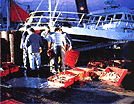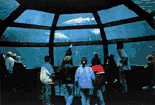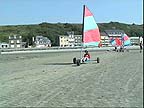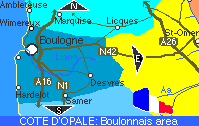|

Boulogne's Old Town, built
within the original Roman walls, and recently well-restored
and regenerated. The rue de Lille (above) leads from the
Cathedral, and is lined with good restaurants vying for the
custom of visitors.

Down by the river, Boulogne's fishing port still bustles
despite European-imposed fishing quotas. Above: unloading
the fish catch ready to sell at the quayside fish market

At Nausicaa sea-life centre by the harbour, find out about
the marine environment - and man's impact on it.
|
France's biggest fishing
port
Boulogne at the mouth of the river Liane is France's biggest
fishing port. It has
been an important town and port since Roman
times, when it was the main link for trade and military
movements between Roman Gaul and Britain.
Medieval town
Later medieval Counts of Boulogne built a castle on one
corner of the old Roman fortifications, and the
Old Town grew up within the Roman walls. By the river,
the Lower Town grew as a port and fishing village within the
protective shadow of the château.
English king Henry VIII besieged and briefly captured
Boulogne from his base in Calais. His stone cannon balls can
still be seen in the crypt of the Cathedral.
Revolution
In the upheavals of the French
revolution, the Cathedral was destroyed.
The town was Napoleon's
base as he prepared for invasion of England in 1802-5. His
army built a monument on their campsite outside the own in
his honour - a column,
with Napoleon's statue on top, originally looking out across
the Channel to the land he planned to capture.
Seaside visitors
After Napoleon was defeated in 1815, the French monarchy
came back to their throne. English people could again visit
Boulogne, amongst English painter Turner who left
many sketches and watercolours of seascapes, sunsets and
scenes of fisher-folk around the coast.
Cathedral
The Catholic Church decided to rebuild the Cathedral
bigger and better as a symbol - it took amost 40 years
(1827-1866). The crypt of the older cathedral was
preserved.
Ferries
Later in the middle of the 19th century it began a
long rivalry with Calais to develop the cross-Channel
ferry trade. The Folkestone- Boulogne route was
developed by steamships operated by the English railway
company, South Eastern Railways - which owned the port of
Folkestone. They ran connecting train-ship-train services
between London and Paris, aimed at wealthy travellers.
At the present time, most of the ferries run the slightly
shorter route between Dover and Calais - Boulogne has been
abandoned by the major ferry operators in their battle with
the tunnel.
Fishing
It is France's biggest fishing port, with a big fish
market.
Seaside
resort
Boulogne is still an attractive seaside resort, with
Nausicaa,
the world-class sea-life centre; sandy beaches and good
facilities for children (recognised as a "KID
Station").
  
"Char-a-voile" - a sail-carting club for children on the
beach. Hire and lessons available.
|









